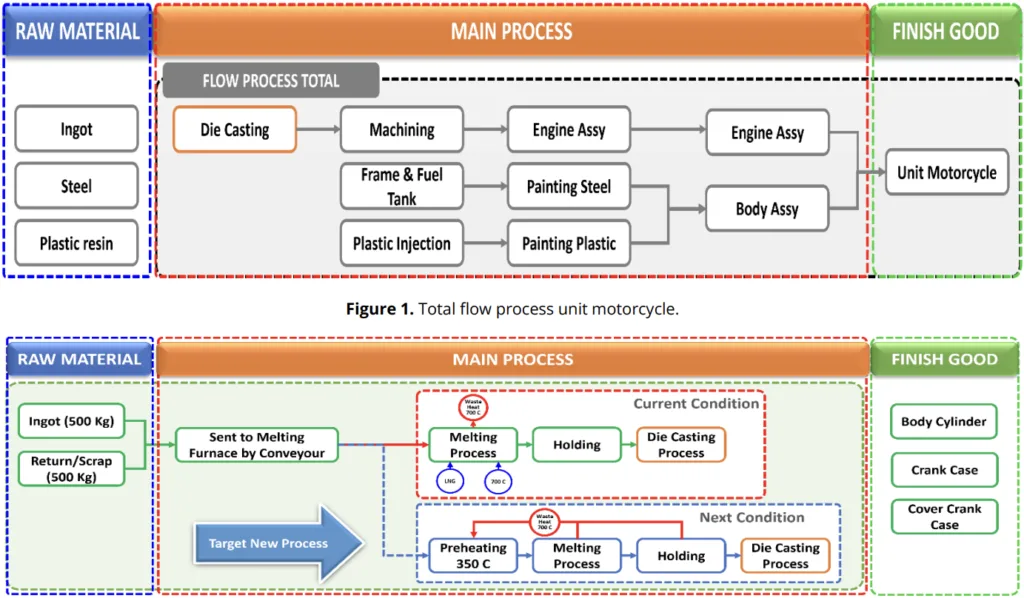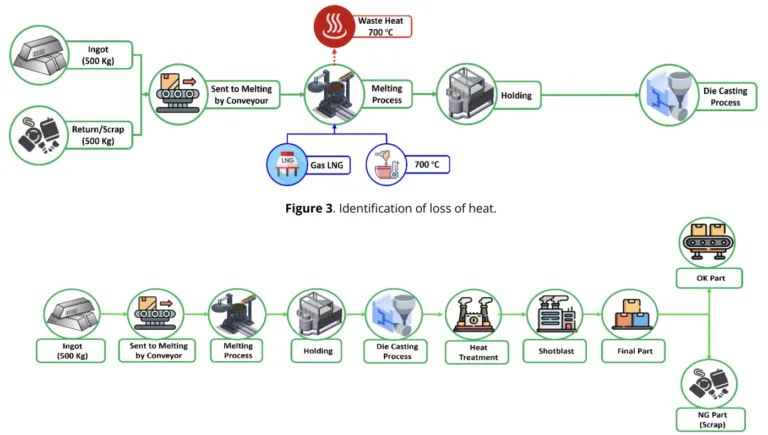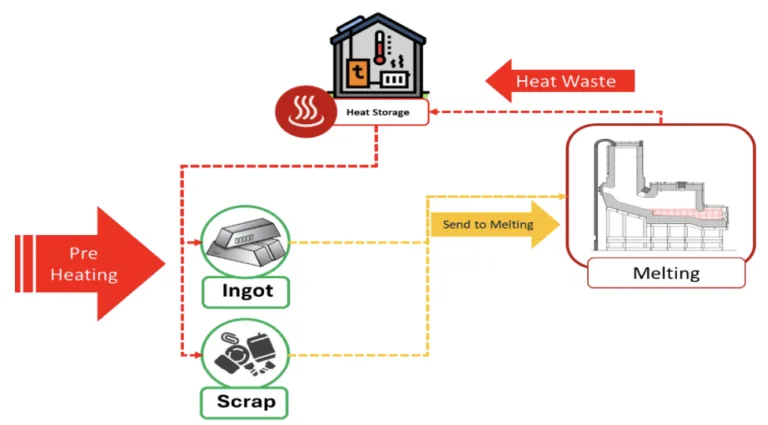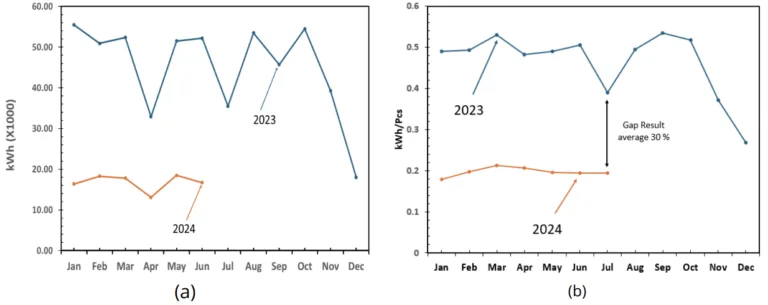This introduction paper is based on the paper "Optimizing Motorcycle Manufacturing Sustainability through the Integration of Waste Heat Recovery and Metal Scrap Recycling: A Process Engineering Approach" published by "Leuser Journal of Environmental Studies".

1. Overview:
- Title: Optimizing Motorcycle Manufacturing Sustainability through the Integration of Waste Heat Recovery and Metal Scrap Recycling: A Process Engineering Approach
- Author: Rifki Saiful, Erkata Yandri, Erik Hilmi, Nasrullah Nasrullah, Uhanto Uhanto, Fitriani Fitriani and Riki Firmandha Ibrahim
- Year of publication: 2024
- Journal/academic society of publication: Leuser Journal of Environmental Studies
- Keywords: Motorcycle manufacturing, Energy efficiency, Waste heat recovery, Sustainability, Energy consumption reduction, Raw material preheating, Material waste recycling
2. Abstract:
The automotive industry manufacturing has experienced rapid growth 2–3 times by 2050, with motorcycles constituting around 30% of vehicles worldwide, but this increase in production has significantly heightened the demand for raw materials and energy. A major challenge arises in managing material waste and waste heat generated during the manufacturing process. This research aims to develop a framework that optimizes the synergy between material waste recycling and waste heat recovery to enhance the sustainability of the motorcycle industry, reduce waste, and lower energy consumption. The design leverages waste heat from the melting process to preheat raw materials, raising temperatures from around 50 °C to 350 °C before melting, thereby reducing additional energy needs, lowering emissions, and decreasing operational costs. Utilizing waste heat for preheating not only mitigates environmental impact and thermal load but also significantly improves energy efficiency, ultimately resulting in cost savings and optimized resource use. Utilizing waste heat directly for preheating raw materials has effectively lowered energy consumption by as much as 30%. This approach not only improves operational efficiency but also decreases production costs and minimizes environmental impact, offering a more sustainable solution for the manufacturing sector.
3. Introduction:
The automotive industry, particularly motorcycle manufacturing, is experiencing rapid growth, leading to increased demand for raw materials and energy. This surge in production exacerbates challenges related to material waste and waste heat management, especially in energy-intensive processes like melting and casting. Aluminum, crucial for engine components, sees a global demand expected to increase 2-3 times by 2050. Its production is energy-intensive and environmentally impactful, particularly in melting and casting processes. The environmental impact of motorcycle manufacturing is increasingly concerning due to inefficiencies and pollution from waste heat and metal scraps. To address these concerns, the industry must adopt sustainable practices including recycling and energy recovery. This paper explores the integration of Waste Heat Recovery System (WHRS) in metal casting and effective management of metal scraps to reduce energy consumption and enhance sustainability in motorcycle manufacturing, addressing a specific gap in the application of these technologies in this sector compared to industries like aluminum and steel.
4. Summary of the study:
Background of the research topic:
The rapid expansion of the automotive industry, with motorcycle manufacturing as a dynamic segment, significantly increases the demand for raw materials and energy. Managing material waste, especially metal scraps, and waste heat generated during manufacturing processes, particularly melting, poses a major sustainability challenge. Unused waste heat contributes to global warming, and discarded aluminum depletes natural resources and exacerbates climate change due to the energy-intensive nature of aluminum production and greenhouse gas emissions.
Status of previous research:
Academic literature extensively explores waste management and heat recovery in manufacturing. Research includes comprehensive reviews of aluminum recycling, energy modeling procedures for thermal process efficiency enhancement using WHRS, technological solutions for heat recovery in steel plants, and methods for measuring energy savings using Energy Management Control System (EMCS). Existing studies also analyze waste heat recovery from aluminum dross and carbon residues, and optimize heat recovery system design using heat pumps. Frameworks for waste heat recovery in the industrial sector have been developed, aiming to reduce energy costs and environmental impact. However, a research gap exists in the specific application of these technologies within the motorcycle manufacturing industry, with most studies focusing on aluminum and steel industries.
Purpose of the study:
This research aims to develop a framework that optimizes the synergy between material waste recycling and waste heat recovery within motorcycle manufacturing. The study focuses on integrating these practices to enhance sustainability, reduce waste, and lower energy consumption in the motorcycle industry, addressing the identified gap in the literature.
Core study:
The core study centers on a process engineering approach to optimize sustainability in motorcycle die casting. It investigates the integration of waste heat recovery from the melting process to preheat raw materials and enhances metal scrap recycling within the manufacturing process. The research analyzes the process flow of motorcycle engine part manufacturing, focusing on the die-casting area. It proposes utilizing waste heat, typically lost during the melting process (at temperatures between 600-750 °C), to preheat raw materials (aluminum ingots and scrap) from approximately 50 °C to 350 °C before they enter the melting furnace. This preheating aims to reduce energy consumption, improve operational efficiency, and minimize environmental impact.
5. Research Methodology
Research Design:
This research employs a process engineering design approach, focusing on analyzing and optimizing the manufacturing process flow in motorcycle die casting. The study develops a conceptual framework for integrating waste heat recovery and metal scrap recycling to enhance sustainability. The design includes analyzing current process conditions and proposing a target new process incorporating waste heat recovery for raw material preheating.
Data Collection and Analysis Methods:
The research collects and analyzes energy consumption data from a motorcycle manufacturing facility. This includes data on electricity and Liquefied Natural Gas (LNG) consumption for various stages of the die-casting process, such as melting, die casting, deburring, and heat treatment. Raw material input data, including the quantities of ingot and return/scrap materials, and total production output are also analyzed. Energy consumption per piece (kWh/Pcs) is calculated and compared before and after implementing the waste heat recovery system. Data from 2023 serves as a baseline for comparison with data from 2024 after the proposed system implementation.
Research Topics and Scope:
The research focuses on the die-casting process in motorcycle manufacturing, specifically analyzing the melting stage as a significant energy consumption point and source of waste heat. The scope includes:
- Process flow analysis of motorcycle engine part manufacturing.
- Identification of waste heat sources in the die-casting process (melting process).
- Design of a waste heat recovery system for preheating raw materials.
- Evaluation of energy consumption reduction through waste heat utilization.
- Analysis of metal scrap recycling contribution to resource efficiency.
- Assessment of potential energy and cost savings, and environmental impact reduction.
6. Key Results:
Key Results:
The key result of this study is the demonstrated potential for significant energy savings through the integration of waste heat recovery for raw material preheating in motorcycle die casting. Utilizing waste heat to preheat raw materials from approximately 50 °C to 350 °C before melting resulted in a reduction of energy consumption by up to 30%. This is evident in the comparison of kWh/Pcs between 2023 and 2024, showcasing a decrease in energy consumption after implementing waste heat recovery. The utilization of waste heat not only reduces energy consumption but also lowers operational costs and minimizes environmental impact by reducing heat emissions. Furthermore, the recycling of scrap parts within the manufacturing process contributes to resource efficiency and reduces the consumption of new raw materials.
Figure Name List:
- Figure 1. Total flow process unit motorcycle.
- Figure 2. Flow process of die casting.
- Figure 3. Identification of loss of heat.
- Figure 4. Return or scrap identification source.
- Figure 5. Flow Utilizing waste heat for pre-heating.
- Figure 6. Comparison of (a) energy consumption and (b) results from utilizing waste heat.
- Figure 7. Flow diagram of waste heat utilization concept.
7. Conclusion:
The concept design integrating exhaust heat utilization and scrap aluminum recycling in motorcycle manufacturing presents a highly effective solution for enhancing sustainability. This integrated system leverages waste heat recovery to maximize energy utilization from the production process and aluminum scrap recycling to minimize dependence on virgin raw materials, thereby reducing resource consumption and CO2 emissions. The implementation of waste heat recovery for preheating raw materials leads to significant energy savings, up to 30% reduction in energy consumption per piece, and improves operational efficiency. This approach not only provides economic benefits but also promotes environmental sustainability by reducing waste and emissions. The research highlights the potential for wider application of such integrated systems in manufacturing industries to achieve greener and more efficient production, contributing to a more sustainable future for motorcycle manufacturing.
8. References:
- [1] Cadavid, L., and Salazar-Serna, K. (2021). Mapping the Research Landscape for the Motorcycle Market Policies: Sustainability as a Trend-A Systematic Literature Review, Sustainability, Vol. 13, No. 19, 10813. doi:10.3390/su131910813.
- [2] Haraldsson, J., and Johansson, M. T. (2018). Review of Measures for Improved Energy Efficiency in Production-Related Processes in the Aluminium Industry from Electrolysis to Recycling, Renewable and Sustainable Energy Reviews, Vol. 93, 525-548. doi:10.1016/j.rser.2018.05.043.
- [3] Liu, W., Peng, T., Kishita, Y., Umeda, Y., Tang, R., Tang, W., and Hu, L. (2021). Critical Life Cycle Inventory for Aluminum Die Casting: A Lightweight-Vehicle Manufacturing Enabling Technology, Applied Energy, Vol. 304, 117814. doi:10.1016/j.apenergy.2021.117814.
- [4] Anastasovski, A., Rasković, P., and Guzović, Z. (2020). A Review of Heat Integration Approaches for Organic Rankine Cycle with Waste Heat in Production Processes, Energy Conversion and Management, Vol. 221, 113175. doi:10.1016/j.enconman.2020.113175.
- [5] Jouhara, H., Khordehgah, N., Almahmoud, S., Delpech, B., Chauhan, A., and Tassou, S. A. (2018). Waste Heat Recovery Technologies and Applications, Thermal Science and Engineering Progress, Vol. 6, 268-289. doi:10.1016/j.tsep.2018.04.017.
- [6] Lodewijk, D. P. Y., Yandri, E., Murdiyansah, N., and Ariati, R. (2024). Cultivating Energy Conscious Communities: The Path to Increased Efficiency, Heca Journal of Applied Sciences, Vol. 2, No. 1, 35-45. doi:10.60084/hjas.v2i1.157.
- [7] Hamja, N., Yandri, E., Hilmi, E., Uhanto, U., and Saiful, R. (2024). Potential for Electrical Energy Savings in AC Systems by Utilizing Exhaust Heat from Outdoor Unit, Heca Journal of Applied Sciences, Vol. 2, No. 2, 64-73. doi:10.60084/hjas.v2i2.223.
- [8] van Ledden, A., Can, M., and Brusselaers, J. (2024). Toward a Greener Future: Investigating the Environmental Quality of Non-Green Trading in OECD Countries, Ekonomikalia Journal of Economics, Vol. 2, Nos. 1 SE-Articles, 15-28. doi:10.60084/eje.v2i1.149.
- [9] Idroes, G. M., Hardi, I., Noviandy, T. R., Sasmita, N. R., Hilal, I. S., Kusumo, F., and Idroes, R. (2023). A Deep Dive into Indonesia's CO2 Emissions: The Role of Energy Consumption, Economic Growth and Natural Disasters, Ekonomikalia Journal of Economics, Vol. 1, No. 2, 69-81. doi:10.60084/eje.v1i2.115.
- [10] El Boudali, J., Mansouri, K., and Qbadou, M. (2022). Modelling the Design of the Reverse Logistics Network for Metal Waste, 2022 2nd International Conference on Innovative Research in Applied Science, Engineering and Technology (IRASET), IEEE, 1-5. doi:10.1109/IRASET52964.2022.9737793.
- [11] Huang, Y.-F., Weng, M.-W., Hoang, T.-T., and Lai, I.-S. (2021). Circular Economy Policy of Bike Industry- Exploring the Optimal ETO Component under Imperfect Production Processes System, 2021 IEEE International Conference on Social Sciences and Intelligent Management (SSIM), IEEE, 1-6. doi:10.1109/SSIM49526.2021.9555214.
- [12] van Hek, S., Can, M., and Brusselaers, J. (2024). The Impact of Non-Green Trade Openness on Environmental Degradation in Newly Industrialized Countries, Ekonomikalia Journal of Economics, Vol. 2, No. 2, 66-81. doi:10.60084/eje.v2i2.148.
- [13] Capuzzi, S., and Timelli, G. (2018). Preparation and Melting of Scrap in Aluminum Recycling: A Review, Metals, Vol. 8, No. 4, 249. doi:10.3390/met8040249.
- [14] Bonilla-Campos, I., Nieto, N., del Portillo-Valdes, L., Egilegor, B., Manzanedo, J., and Gaztañaga, H. (2019). Energy Efficiency Assessment: Process Modelling and Waste Heat Recovery Analysis, Energy Conversion and Management, Vol. 196, 1180-1192. doi:10.1016/j.enconman.2019.06.074.
- [15] Ortega-Fernández, I., and Rodríguez-Aseguinolaza, J. (2019). Thermal Energy Storage for Waste Heat Recovery in the Steelworks: The Case Study of the REslag Project, Applied Energy, Vol. 237, 708-719. doi:10.1016/j.apenergy.2019.01.007.
- [16] Yandri, E., Suherman, S., Lomi, A., Setyobudi, R. H., Ariati, R., Pramudito, P., Ronald, R., Ardiani, Y., Burlakovs, J., Zahoor, M., Shah, L. A., Fauzi, A., Tonda, R., and Iswahyudi, I. (2024). Sustainable Energy Efficiency in Aluminium Parts Industries Utilizing Waste Heat and Equivalent Volume with Energy Management Control System, Proceedings of the Estonian Academy of Sciences, Vol. 73, No. 1, 29-42. doi:10.3176/proc.2024.1.04.
- [17] Yang, F., Yu, Q., Zuo, Z., and Hou, L. (2021). Thermodynamic Analysis of Waste Heat Recovery of Aluminum Dross in Electrolytic Aluminum Industry, Energy Sources, Part A: Recovery, Utilization, and Environmental Effects, Vol. 43, No. 9, 1047-1059. doi:10.1080/15567036.2019.1634163.
- [18] Wang, J., Wang, Z., Zhou, D., and Sun, K. (2019). Key Issues and Novel Optimization Approaches of Industrial Waste Heat Recovery in District Heating Systems, Energy, Vol. 188, 116005. doi:10.1016/j.energy.2019.116005.
- [19] Yandri, E., Pramudito, P., Ronald, R., Ardiani, Y., Ariati, R., Setyobudi, R. H., Widodo, W., Zahoor, M., Zekker, I., and Lomi, A. (2022). Technical Design of Aluminium Scrap Processing Machines by Utilizing Direct Exhaust Air Using Conveyor Drying System, Proceedings of the Estonian Academy of Sciences, Vol. 71, No. 2, 178-185. doi:10.3176/proc.2022.2.01.
- [20] Brough, D., and Jouhara, H. (2020). The Aluminium Industry: A Review on State-of-the-Art Technologies, Environmental Impacts and Possibilities for Waste Heat Recovery, International Journal of Thermofluids, Vols 1-2, 100007. doi:10.1016/j.ijft.2019.100007.
- [21] Woolley, E., Luo, Y., and Simeone, A. (2018). Industrial Waste Heat Recovery: A Systematic Approach, Sustainable Energy Technologies and Assessments, Vol. 29, 50-59. doi:10.1016/j.seta.2018.07.001.
- [22] Macedo, C., Freitas, C., Brito, A. M., Santos, G., Faria, L., Laranjeira, J., and Simoes, R. (2019). Influence of Dynamic Temperature Control on the Injection Molding Process of Plastic Components, Procedia Manufacturing, Vol. 38, 1338-1346. doi:10.1016/j.promfg.2020.01.155.
- [23] Su, Z., Zhang, M., Xu, P., Zhao, Z., Wang, Z., Huang, H., and Ouyang, T. (2021). Opportunities and Strategies for Multigrade Waste Heat Utilization in Various Industries: A Recent Review, Energy Conversion and Management, Vol. 229, No. August 2020, 113769. doi:10.1016/j.enconman.2020.113769.
- [24] Papapetrou, M., Kosmadakis, G., Cipollina, A., La Commare, U., and Micale, G. (2018). Industrial Waste Heat: Estimation of the Technically Available Resource in the EU per Industrial Sector, Temperature Level and Country, Applied Thermal Engineering, Vol. 138, 207-216. doi:10.1016/j.applthermaleng.2018.04.043.
- [25] Dokl, M., Gomilšek, R., Čuček, L., Abikoye, B., and Kravanja, Z. (2022). Maximizing the Power Output and Net Present Value of Organic Rankine Cycle: Application to Aluminium Industry, Energy, Vol. 239, 122620. doi:10.1016/j.energy.2021.122620.
- [26] Salonitis, K., Jolly, M., Pagone, E., and Papanikolaou, M. (2019). Life-Cycle and Energy Assessment of Automotive Component Manufacturing: The Dilemma Between Aluminum and Cast Iron, Energies, Vol. 12, No. 13, 2557. doi: 10.3390/en12132557.
- [27] Liu, Y., and Xiong, S. (2024). Research Progress on Thermal Conductivity of High-Pressure Die-Cast Aluminum Alloys, Metals, Vol. 14, No. 4, 370. doi:10.3390/met14040370.
- [28] Haraldsson, J., Johnsson, S., Thollander, P., and Wallén, M. (2021). Taxonomy, Saving Potentials and Key Performance Indicators for Energy End-Use and Greenhouse Gas Emissions in the Aluminium Industry and Aluminium Casting Foundries, Energies, Vol. 14, No. 12, 3571. doi:10.3390/en14123571.
- [29] Oyedepo, S. O., and Fakeye, B. A. (2021). Waste Heat Recovery Technologies: Pathway to Sustainable Energy Development, Journal of Thermal Engineering, Vol. 7, No. 1, 324-348. doi:10.18186/thermal.850796.
- [30] Wazeer, A., Das, A., Abeykoon, C., Sinha, A., and Karmakar, A. (2023). Composites for Electric Vehicles and Automotive Sector: A Review, Green Energy and Intelligent Transportation, Vol. 2, No. 1, 100043. doi:10.1016/j.geits.2022.100043.
- [31] Wu, W., Du, Y., Qian, H., Fan, H., Jiang, Z., Zhang, X., and Huang, S. (2024). Enhancing the Waste Heat Utilization of Industrial Park: A Heat Pump-Centric Network Integration Approach for Multiple Heat Sources and Users, Energy Conversion and Management, Vol. 306, 118306. doi:10.1016/j.enconman.2024.118306.
- [32] Thompson, A., and Taylor, B. N. (2008). Use of the International System of Units (SI), NIST Special Publication, Gaithersburg.
- [33] Dhiman, B., and Bhatia, O. S. (2015). Oil Fired Furnace and Induction Furnace: A Review, International Journal of Scientific & Engineering Research, Vol. 6, No. 8, 602-613.
- [34] Díaz-Romero, D., Sterkens, W., Van den Eynde, S., Goedemé, T., Dewulf, W., and Peeters, J. (2021). Deep Learning Computer Vision for the Separation of Cast and Wrought-Aluminum Scrap, Resources, Conservation and Recycling, Vol. 172, 105685. doi:10.1016/j.resconrec.2021.105685.
- [35] Chowdhury, J. I., Hu, Y., Haltas, I., Balta-Ozkan, N., Matthew, G. J., and Varga, L. (2018). Reducing Industrial Energy Demand in the UK: A Review of Energy Efficiency Technologies and Energy Saving Potential in Selected Sectors, Renewable and Sustainable Energy Reviews, Vol. 94, 1153-1178. doi:10.1016/j.rser.2018.06.040.
- [36] Xu, Z. Y., Wang, R. Z., and Yang, C. (2019). Perspectives for Low-Temperature Waste Heat Recovery, Energy, Vol. 176, 1037-1043. doi:10.1016/j.energy.2019.04.001.
- [37] Meng, Y., Yang, Y., Chung, H., Lee, P.-H., and Shao, C. (2018). Enhancing Sustainability and Energy Efficiency in Smart Factories: A Review, Sustainability, Vol. 10, No. 12, 4779. doi:10.3390/su10124779.
- [38] Elsaid, K., Taha Sayed, E., Yousef, B. A. A., Kamal Hussien Rabaia, M., Ali Abdelkareem, M., and Olabi, A. G. (2020). Recent Progress on the Utilization of Waste Heat for Desalination: A Review, Energy Conversion and Management, Vol. 221, 113105. doi:10.1016/j.enconman.2020.113105.
- [39] Yang, J., Zhang, Z., Yang, L., Hong, M., Bie, Y., Xu, T., and Chen, J. (2023). Coupling Effect between Waste Heat Recovery and Government Subsidy with Supply Chain as a Pivot, Sustainable Cities and Society, Vol. 99, 104897. doi:10.1016/j.scs.2023.104897.
- [40] Christodoulides, P., Aresti, L., Panayiotou, G. P., Tassou, S., and Florides, G. A. (2022). Adoption of Waste Heat Recovery Technologies: Reviewing the Relevant Barriers and Recommendations on How to Overcome Them, Operations Research Forum, Vol. 3, No. 1, 3. doi:10.1007/s43069-021-00108-6.
- [41] Uhanto, U., Yandri, E., Hilmi, E., Saiful, R., and Hamja, N. (2024). Predictive Maintenance with Machine Learning: A Comparative Analysis of Wind Turbines and PV Power Plants, Heca Journal of Applied Sciences, Vol. 2, No. 2, 87-98. doi:10.60084/hjas.v2i2.219.
9. Copyright:
- This material is a paper by "Rifki Saiful, Erkata Yandri, Erik Hilmi, Nasrullah Nasrullah, Uhanto Uhanto, Fitriani Fitriani and Riki Firmandha Ibrahim". Based on "Optimizing Motorcycle Manufacturing Sustainability through the Integration of Waste Heat Recovery and Metal Scrap Recycling: A Process Engineering Approach".
- Source of the paper: https://doi.org/10.60084/ljes.v2i2.225
This material is summarized based on the above paper, and unauthorized use for commercial purposes is prohibited.
Copyright © 2025 CASTMAN. All rights reserved.



